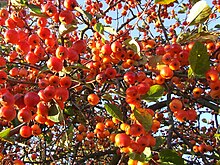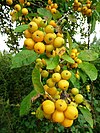
Malus is a genus of about 30–55 species of small deciduous trees or shrubs in the family Rosaceae, including the domesticated orchard apple, crab apples, wild apples, and rainberries.
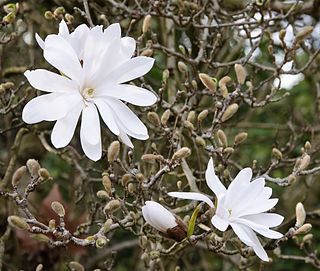
Magnolia stellata, sometimes called the star magnolia, is a slow-growing shrub or small tree native to Japan. It bears large, showy white or pink flowers in early spring, before its leaves open. This species is closely related to the Kobushi magnolia, and is treated by many botanists as a variety or even a cultivar of that. However, Magnolia stellata was accepted as a distinct species in the 1998 monograph by Hunt.

Abutilon pictum, syn. Abutilon striatum (disputed), is a species of flowering plant in the family Malvaceae. It is native to southern Brazil, Argentina, Paraguay and Uruguay. The plant has become naturalised in Central America, and is used in horticulture. Common names include redvein abutilon, red vein Indian mallow, redvein flowering maple, Chinese-lantern and red vein Chinese lanterns.

Cornus alba, the red-barked, white or Siberian dogwood, is a species of flowering plant in the family Cornaceae, native to Siberia, northern China and Korea. It is a large deciduous surculose (suckering) shrub that can be grown as a small tree. As a popular ornamental used in landscaping its notable features include the red stems in fall (autumn) through late winter, bright winter bark; and the variegated foliage in some cultivars, such as C. alba 'Elegantissima'. C. alba can grow to 3 m (10 ft) high, but variegated forms are less vigorous. For the brightest winter bark, young shoots are encouraged by cutting to the ground some older stems at the end of the winter, before leaves are open. The oval fruits are white, sometimes tinted blue.
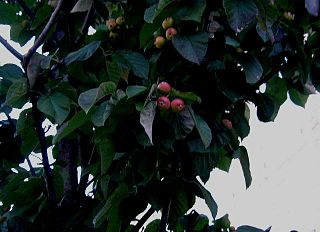
Malus tschonoskii is a species of flowering plant in the family Rosaceae, native to Japan.

Tecoma capensis, the Cape honeysuckle, is a species of flowering plant in the family Bignoniaceae, native to southern Africa. Despite its common name, it is not closely related to the true honeysuckle.

Malus floribunda, common name Japanese flowering crabapple, Japanese crab, purple chokeberry, or showy crabapple, originates from Japan and East Asia. It may be a hybrid of M. toringo with M. baccata, in which case it would be written as Malus × floribunda.
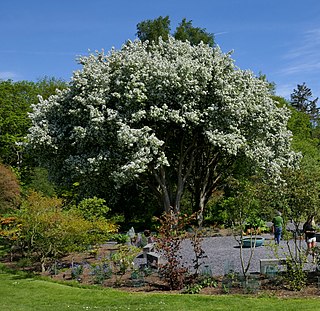
Malus hupehensis, common names Chinese crab apple, Hupeh crab or tea crabapple, is a species of flowering plant in the apple genus Malus of the family Rosaceae.

Sorbus sargentiana, Sargent's rowan is a species of flowering plant in the family Rosaceae, native to southwestern Sichuan and northern Yunnan in China, where it grows at altitudes of 2,000–3,200 m (6,560–10,500 ft).

Malus fusca, with the common names Oregon crabapple and Pacific crabapple, is a species of crabapple native to western North America.

Malus angustifolia, or southern crabapple, is a species of crabapple native to the eastern and south-central United States.

Malus baccata is an Asian species of apple known by the common names Siberian crab apple, Siberian crab, Manchurian crab apple and Chinese crab apple. It is native to much of northern Asia, but is also grown elsewhere as an ornamental tree and for rootstock. It is used for bonsai. It bears plentiful fragrant white flowers and edible red to yellow fruit of about 1 centimetre diameter.
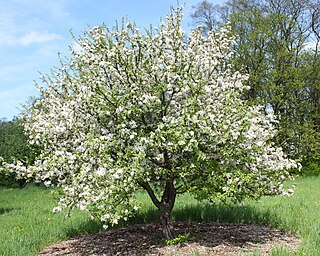
Malus prunifolia is a species of crabapple tree known by the common names plumleaf crab apple, plum-leaved apple, pear-leaf crabapple, Chinese apple and Chinese crabapple. It is native to China, and is grown elsewhere for use as an ornamental tree or as rootstock. It reaches from between 3 and 8 meters tall and bears white flowers and yellow or red fruit.

Malus sargentii, the Sargent crabapple or Sargent's apple, is a species of flowering plant in the genus Malus of the family Rosaceae. The species was formerly considered a variety of the species Malus sieboldii. It is a shrub or small tree growing to 6–10 ft (1.8–3.0 m) tall and 6–12 ft (1.8–3.7 m) broad.

Malus transitoria, the cut-leaf crabapple, is a species of flowering plant in the crabapple genus Malus of the family Rosaceae, native to China.
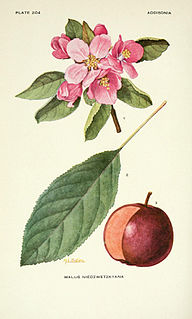
Malus niedzwetzkyana, or Niedzwetzky's apple, is a kind of apple native to certain parts of China, Afghanistan, Kazakhstan, Kyrgyzstan, and Uzbekistan noted for its red-fleshed, red-skinned fruit and red flowers. Some botanists consider it a distinct species, while others have argued it is simply an unusual variety of the common apple, Malus pumila.
Applecrabs are various hybrids between crabapples and apples. They are bred for varying reasons, including disease resistance and use in cold climates because they are often hardier than apple trees and their fruit has the good eating qualities of apples.

Malus × robusta, called Siberian crab apple along with other members of its genus, is a hybrid species of flowering plant in the family Rosaceae. It is the result of a cross between Malus baccata and Malus prunifolia. It is being studied for its resistance potential to fire blight. Known for its attractive fruit that remain on the tree well into winter, its cultivar 'Red Sentinel' has gained the Royal Horticultural Society's Award of Garden Merit as an ornamental.

Malus × zumi is a naturally occurring hybrid species of crabapple in the family Rosaceae, native to Japan, and a garden escapee in the US state of Ohio. Its parents are Manchurian crab apple Malus mandshurica and Siebold's crabapple Malus sieboldii. It is used as a salt‑tolerant rootstock for apples, Malus domestica, as it can survive NaCl concentrations up to 0.6%. A number of ornamental cultivars are available, including 'Golden Hornet' and 'Professor Sprenger'.


